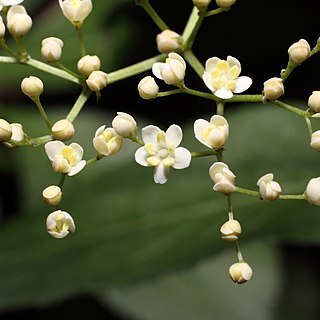Shrubs or small trees, 5-6 m tall. Old branches reddish brown, with conspicuous, narrowly elliptic lenticels; pith brownish. Leaves imparipinnate; leaflets (1 or)2-or 3(-5)-jugate; lateral leaflets ovate-orbicular or narrowly elliptic to oblong-oblanceolate, 5-15 × 1.2-7 cm, base cuneate or rounded, sometimes cordate, asymmetrical, margin irregularly serrate, sometimes with 1 to several glandular teeth at base or below middle, apex acute to acuminate or caudate; lowest pair of leaflets sessile or petiole to ca. 0.5 cm; terminal leaflet ovate or obovate, adaxially sparsely pubescent when young, glabrescent, petiolule ca. 2 cm, base cuneate, apex acuminate or caudate; stipules narrowly linear or reduced to bluish protrusions. Inflorescences terminal cymose panicles, 5-11 × 4-14 cm, pedunculate, sometimes sparsely pubescent, soon glabrescent. Flowers appearing simultaneously with leaves, dense; calyx tube urceolate, ca. 1 mm, lobes triangular-lanceolate, slightly shorter than tube; corolla pinkish in bud, white or yellowish when open; tube short; lobes oblong or narrowly ovate-orbicular, ca. 2 mm; stamens spreading, ca. as long as corolla lobes; filaments slightly dilated at base; anthers yellow; ovary 3-loculed; styles short; stigmas 3-lobed. Fruit red, rarely bluish or purplish black, ovoid or subglobose, 3-5 mm in diam.; pyrenes 2 or 3, ovoid to ellipsoid, 2.5-3.5 mm, slightly rugose. Fl. Apr-May, fr. Sep-Oct. 2n = 36*.
More
A shrub. It loses its leaves during the year. It grows 3-6 m high. The branches have lines along them and they have a yellow pith. The leaves are opposite and compound. They have leaflets along the stalk. There are 5-7 leaflets and these are broadly oval and 5-12 cm long by 2-4 cm wide. There are coarse teeth along the edge. The flowers are white but turn pale yellow. They occur as a group at the ends of branches. The fruit is like a berry and blue-purple. It is juicy and 4-5 mm across.

